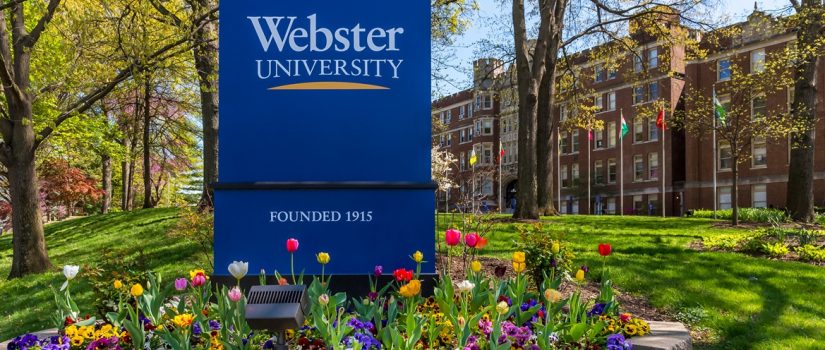Getting To Know: Webster University (MO)
Peter Pitts, aka ‘The Small College Guy’, introduced me to Monmouth College (IL), which is profiled here. Then he introduced me to Webster University, located in Webster Grove, a bucolic suburb close to St. Louis. He introduced me to Andrew Laue, associate director of admissions. We had an interesting chat that you should check out before you read on. Andrew also shared the photos that I have dropped in this post.
This school was on shaky financial footing for the past 12 years. However, the university announced that it was in a cash flow positive situation in January, 2025. Webster was more like an over-extended university system in prior years, with several US locations, including military bases, as well as locations abroad. The turnaround is remarkable in higher education.
From my distant seat in New Jersey, Webster University reminded me of Pace University in Westchester County, New York.
- They have about the same number of undergrads (2,000 vs. 2,400).
- Freshman retention rates (77 percent) and four-year graduation rates (50 percent) are about the same.
- Both schools have upped the ante with their investments in programs in business, communications, computer science, health professions and the performing arts.
- Their campuses preserve older buildings fairly well, but do not use the older buildings as a basis for new designs.
- Both schools reply on part-time adjunct faculty to do much of the teaching. This has pluses: students get to learn from working professionals in an industry where they might want to work. But there’s a downside: adjunct faculty come and go. They might not always be reachable for advice or recommendations after they leave.
But it also might be fairer to state that Webster University is a blend of Pace and Northeastern University in Boston. Webster operates its own campuses in eight cities around the globe and partners with other institutions to offer study abroad in other cities. The physical locations of these campuses make it easier for students to have more international experiences than they might have at other schools, including internships.
There’s also another important difference between Webster and Pace. Webster’s estimated total cost of attendance is lower than Pace’s charges for tuition and fees alone. Scholarships also help keep student loan debt to extremely reasonable levels for a private college. The average borrower in the Class of 2023 owed less than $15,000. Webster might not undercut Home State U for most students, but the tuition and fees are lower than many state universities charge non-resident students.
Andrew also told me that schools that applicants consider, especially other arts programs, include Chapman University (CA) and DePaul University (IL). I cannot comment on Chapman, since I have not been there. But I believe that students who consider Webster vs. DePaul will find Webster to be a more peaceful, less intimidating campus setting.
What are some of Webster’s strengths?
Personallu, I liked the US campus. It is attractive, easily navigable and close to a major city with plenty for college students tp do. The main campus is also quite nice for an urban location. It’s also within ten minutes from downtown St. Louis by car or bus. Webster Groves along with its neighbor,ing neighborhood, Kirkwood, are considered two of the nicest and best preserved communities inf the metro area.
I also saw many majors, especially in the perfuming arts such as Costume Design, Costume Construction, Set Design, and Lighting Design and others that are quite tough to find. The communications equipment and facilities are quite impressive. The same is true for instruction in computer science. There’s an effort not only to “offer a program,” but also to keep it up to date. This was especially true for cybersecurity communications and theatre arts, which are conservatory based. I dropped photos from both programs below.

I also liked the idea behind the international sites. The classes are small, there are some nice downtown locations (Leiden and Vienna, for example) and students can intern as well as take classes. It is possible to receive an education at more than one campus site, whether in Webster Groves or abroad. But that will depend on the major, available classes, and careful planning to graduate on time.
Given its location it would be expected that the school’s largest alumni base would be in the St. Louis metro area. However, I found that there were nearly 2,700 alumni based in/around Orlando, Florida alone registered in LinkedIn.com as well as over 6,000 in/around Washington DC and over 5,300 in South Carolina. The school advertises that it has over 200,000 alumni worldwide.
What are some of the wesknesses?
To me this seems tied to what you want to study and the connections the school might have. The St. Louis area is not as “happening” a place for the arts as larger cities such as Chicago, Los Angeles or New York. It’s also hard for the school to gain brand recognition with a market that includes Washington University in St. Luis, a globally respected research university, St. Louis University, a Jesuit institution that has a medical school and strong career services, and the St. Louis campus of the University of Missouri.
Webster has its own unique mascot.
Most colleges use a real animal or object as their mascot. Webster created its own called a Gorlok. The Gorlok is a unique combination of a cheetah’s paws, a buffalo’s horns, and a Saint Bernard’s face. The mythical mascot’s look has evolved over 40 years. This might be one of the few schools where the mascot is better known than the historical performances of any of the varsity teams.
Conclusions
Webster University offers over 100 majors, huge for a small school, and some are unique enough for the school to deserve more attention. This is especially true for students interest in communications, film and theatre.
However, I also felt that Webster was a school where your social fit ties more tightly with your academic fit than it might at other colleges. Either you find a supportive group to help you get through the work, or you end up leaving, possibly giving up on a potential career. This appears to be reflected in the low retention and graduation rates. On the other hand, if things work out, you can have an extremely rewarding life after college.
Listen tp my conversation with Andrew Laue now!
The Report Card for Webster University (MO)
- Four-Year/Six-Year Graduation Rates: C/C
- Freshman Retention:C
- Costs: A
- Comforts: B+
- Community: B+
- Curriculum: A
- Connections: A (Missouri/Florida/Texas/South Carolina)/B (California)/C (elsewhere)
Buy my new book, The Good College!
Listen to my latest interview on ‘Tests and the Rest’ with Amy Seeley and Mike Bergin!
Check out my talk, What Exactly Is a Good College? hosted by test-prep experts Amy Seeley and Mike Bergin on Tests And The Rest!
Listen to my talk, College Is A Learning AND Living Community hosted by Dr. Cynthia Colon from Destination YOUniversity on Voice of America Radio!
Sharing is caring!

